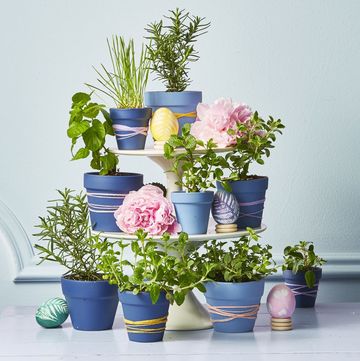I’d been in advertising for 12 years, working in brand strategy and on the board of a big agency. I had a corner office, a Blackberry and a gold card… so far, so good. Then, a few years into our careers, my husband, Paul, and I had decided to move out of London and try more rural living.
We decided on the Cotswolds, which was close to my parents. Theoretically, it was an easy commute to London. But all it did was add a four-hour round trip to our day. I successfully did it for five or six years, gradually getting more and more senior – when apparently from nowhere, over the course of a number of weeks, my brain seemed to start shutting down. I remember going to get in the car, and knowing there was something about the key that was going to make the car start, but I didn’t know what. I got in the shower, and then couldn’t remember how to make the water come out.
I initially put it down to jet lag or brain fog, but then realised that actually, I just really was not coping. I felt like all the skin had been removed from me, and everything was overwhelming – every word, every noise, every door shutting, every light flashing on my Blackberry. And I had an inexplicable grief, for no reason. I had a wonderful life. We were child-free by choice, I had a husband who loved me, a family who were well, I was earning good money. Everything was fine, but I felt like the sun might not rise the next morning.
In the end, I just couldn’t get out of bed any more and I was signed off work. It’s so inconsequential, really, but at the time, it felt like the biggest failure. I went to my GP, who told me I had quite severe depression. ‘You’re not going back to work,’ she said, ‘and you’re going to start taking these drugs.’
Every day, Paul would go to work and my mum would sit and watch over me. Eventually, after a few months, she coaxed me into the garden with a cup of tea. I couldn’t make tea at that time, and I could barely get out of bed, but it was late-summer and she said: ‘Just go outside.’ And I did it. I sat in the garden – and my world changed.
The garden itself had been totally neglected. We’d put in raised beds when we’d first moved in but had been too busy to focus on it. I sat among the veg beds and watched the insects and worms – and it occupied my mind. I realised I could sit there and watch a bug worry about a little piece of bark that was in its way, and somehow everything was just silent. My head was momentarily not filled with criticism and grief. Then, one day, I found an old packet of radish seeds in the house and I scattered them among the weeds. They grew – and I found it amazing.
As the weeks passed, I continued to find the radishes magical. Something that I could eat had come out of just a handful of seeds. I started sowing a lot – my failure rate was really high. But I found a joy in the chaos of the vegetable patch. If the seeds didn’t work, it didn’t matter. I could just re-sow them.
That realisation was hugely liberating. I carried on with the radishes and planted lettuce, too, then other veg – cabbage and carrots, peas and runner beans. The veg patch gave me a real sense of agency. I’d experienced months of being ferried backwards and forwards to doctors, therapists and various institutions, and now I’d grown something that I could nourish myself with. It’s oddly political in a way – taking back a bit of control of your own existence and your own care.
I began to realise I was capable of other things, too, and a year into my vegetable discovery, I wrote to the head grower at Dalesford Organic, who said he needed some pickers. I was delighted by it, and I loved it. It was a fabulous atmosphere to be in that kind of garden every day, growing and picking. Eventually, I got a job in the cookery school, which gave me more time to start private cooking and supper clubs, featuring food I’d grown.
It’s a decade or so since that first radish glut, and it would be tempting to finish this story by saying that vegetables saved my life. But that would be glib and an oversimplification. It would negate the drugs, the therapy, the spaniel, the relentless care and patience of my family and friends, all of which made a profound difference. And it might imply that a life-changing and debilitating illness can be cured simply by getting out in the fresh air and growing some lettuce. Or, indeed, that it can be cured at all. But the veg patch was significant because it was a gateway to something far bigger. The simple act of seeing a seed turn into supper was restorative in ways I’m only now coming to appreciate.
Top tips for growers
Go for easy wins
And I would say that for anyone starting a garden, take it a step at a time instead of trying to do it all then feeling like you’ve failed. Think: ‘I’m just going to start with one of the beds. I’m going to cover everything else and ignore it.’ The following year, you can build up. Don’t start by growing a melon or a cauliflower… cauliflowers are impossible. Start with easy stuff.
Let go of perfectionism
As long as the weeds are smaller than the vegetables, you’re going to be fine. There’s a joy in the chaos of the vegetable patch. If the seeds don’t work, it doesn’t matter. You can just re-sow them
Start with radishes
They’re so easy and you can grow them in a window box. They’ll be ready in four or five weeks. My favourite radish recipe is what I call a radish slammer, which is like a tequila slammer but without a hangover. Take a radish, smear it in butter, and then press it into really good-quality flaky salt before eating it.
Tomatoes do need a bit of attention
If you’re new to growing, try Gardener’s Delight. The clue’s in the name – it’s such a doer. I love the heritage varieties, but they’re heritage exactly because they’re trickier to grow.
If you have a patio, try courgettes in pots
They do need a lot of water, but once the plant is happy, you’ll get a courgette a day. Start with something like a Defender, which is a good, stalwart green variety. I don’t cook my courgettes; use a potato peeler to make ribbons, toss in lemon, olive oil and salt, and you’ll get this amazing salad.
Experienced growers should try aubergines
They need to be grown undercover and need a long growing season; sow them in February, ideally with some sort of heat under them, then keep them in a greenhouse. But it’s wonderful when you get a beautiful, glossy aubergine.
Pumpkins are worth the wait
They’re not particularly difficult to grow, but they do take their time. I recommend starting with the Crown Prince variety. A stuffed pumpkin is so dramatic to take to the table, full of sausage meat and mushrooms and pearl barley.














